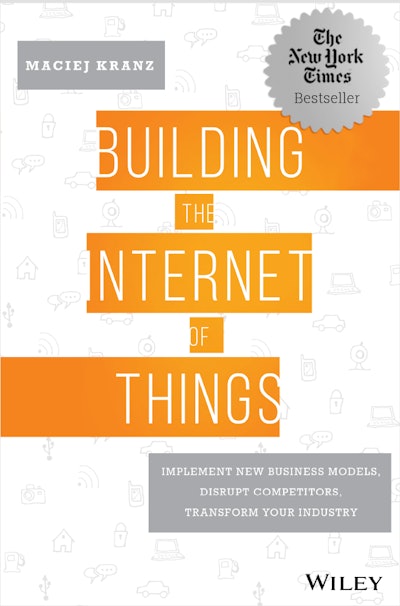
 Maciej Kranz
Maciej KranzChanging Roles and Golden Opportunities
If it hasn’t become apparent yet, people will have new roles. Will the chief information officer become the chief IoT officer instead? Will LOB managers become change agents? How will the plant control engineer’s role change in the face of IoT and automation? Will you need a chief supply chain management officer? Can one person handle the information security office? What about the top data administrator? Does he or she become the chief data officer? Who will oversee integration, compliance,
and logistics, among other things? These questions don’t need to be answered immediately, but somebody — or more likely a handful of somebodies — needs to start thinking about this, talking about it, and eventually making some decisions.
Another interesting area that will change revolves around your products and services and their development. How will your IoT-based products be conceived, developed, supported, priced, and marketed? How many forms will they take? How will customers fi nd them, buy them, and receive them? Remember our earlier discussion about the different ways you can buy a book or a car? This must be thoroughly considered for your company, your products and services, and your industry.
To be clear, IoT transformation creates a golden opportunity, one that doesn’t come often — you have the opportunity to completely rethink your products, services, and development from the ground up. What will emerge is the chance to totally reinvent your product, company, industry, and market. Can you use IoT to sell and deliver your product as a service on a subscription basis? If so, what would the economics of that look like? Think about it.
Some industries may be utterly disrupted. Others may experience barely a ripple. The opportunities, however, are there for products and services, the same ones you have today — or different. There will be new ways to go to market and new markets to serve, with new and different products and services delivered in new and different ways. I don’t know about you, but for me just thinking about it can be very exciting. With IoT, anything can become a greenfield opportunity ready to be explored anew.
Say your company produces airplanes today. But with the advent of drones, autonomous cars, and the super-fast Hyperloops, will you still be making these aircraft 20 years from now? Will you be in the airplane- making business, the transportation business, or the mobility business? The car industry is already going through this transformation, rethinking its basic value propositions, business models, value chains, and go-to-market strategies. Faced with massive disruption, the industry is rapidly rethinking itself. It isn’t too much of a stretch to imagine that the airplane and car industries could eventually converge. If that happens, who will be better prepared and positioned to lead the new mobility industry? After all, in the same way we now talk about the car becoming a smartphone on wheels, it could be argued that an airplane could become just a multi-passenger drone or a car with wings. . . .
One interesting possibility that springs from IoT is the emergence of the converged software and hardware economy. IoT will produce an insatiable demand for software, development platforms, APIs, and even API exchanges to take actions with the various things you’ve connected. I’m not talking about millions and millions of lines of code. It’s more likely those short, fast applets or micro-services that can be cranked out quickly and revised even more quickly. But these capabilities are balanced with similar trends in hardware, with modules, programmability, and rapid development cycles. It is like yin and yang building on each other. The fog computing trend is a perfect example, where the need for real-time analytics meets the need to connect all the devices and capture and process the data in motion they generate.
Learn and Share
In short, don’t reinvent the wheel; instead, learn from your IoT peers. Think of this as just another part of the same message I’ve been sending throughout this book: Don’t try to do it all on your own. The entire IoT industry is feeling its way, discovering what works and what doesn’t, and learning not
160 Building the Internet of Things only which use cases to tackle but also how to implement them. In the same spirit, you don’t have to be a solitary hero. You can learn from the successes and the mistakes of others. Share what works for you and what doesn’t. In effect, you’re going to be both a student of IoT and a teacher.
You should, of course, attend IoT conferences. A few are held each year, and I expect many more will pop up as industry after industry jumps on the IoT bandwagon and eagerly learns what works. It will quickly reach the point where you’ll have to be selective about which events you attend, making choices based in part on the use cases presented. At conferences, seek out opportunities to talk one-on-one with the presenters and either ask questions on site or follow up with them later.
Plan to talk with your peers, but don’t narrow your scope so tightly that you’ll miss important insights and experience. For instance, if you’re in the discrete manufacturing industry, you can still learn from the implementation of a remote operations solution in the banking industry. When I talk with customers about IoT, I often ask them what they would do differently if they were doing it again. You’ll be surprised how many people are willing to share their experiences and help you. The same goes for consultants. The experienced IoT firms or individuals could bring a wealth of practical knowledge to you and help you dramatically reduce the learning curve and the project risk.
You’ll have plenty of opportunities to join your peers in industry-level test beds, some of which are created by industry members and some co-sponsored by the government. The Southeast Michigan Test Bed for autonomous vehicles or the interoperability test beds run under the Industrial Internet Consortium (IIC) or the ODVA, an industrial automation consortium, are just three examples. This is a very practical way to converge the industry, resolve key issues and accelerate the adoption of technologies and solutions, all done together with your peers.
You can also establish either a formal or an informal external advisory board to support your IoT efforts. The members will automatically become a group of mentors, from whom you can learn and with whom you can share. Remember, all of these conversations are two-way exchanges. By the way, this group doesn’t have to be large or highly structured. Your advisory board might get together only every few months. You can hold the meetings on-line or in your conference room and just bring in sandwiches, so it doesn’t have to be expensive, either.
Excerpted from BUILDING THE INTERNET OF THINGS: Implement New Business Models, Disrupt Competitors, Transform Your Industry by Maciej Kranz. Copyright © 2016, Wiley.
 by Maciej Kranz
by Maciej Kranz





















